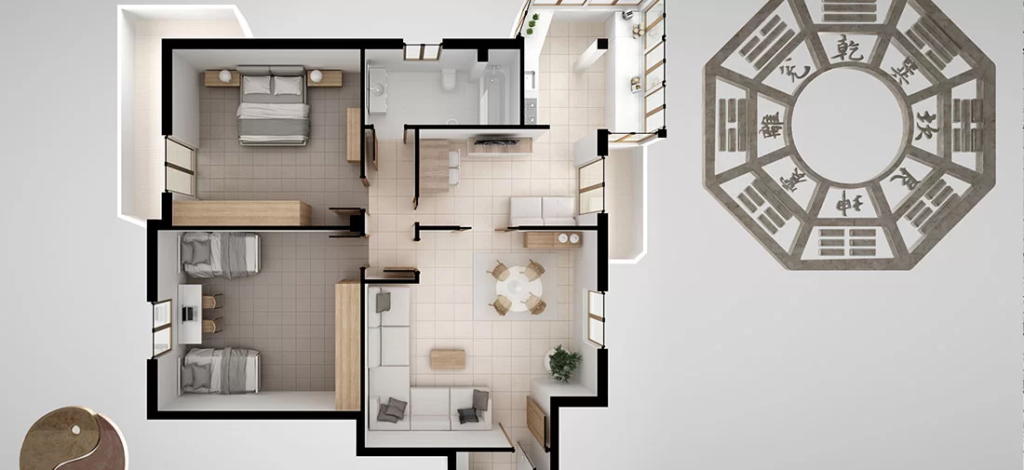
Table of Contents
What is Feng Shui in Architecture?
Feng Shui is an ancient Chinese practice that aims to harmonize the energy flow in a space, bringing balance and prosperity to its inhabitants. When applied to architecture, it involves the strategic placement of buildings, rooms, and objects to enhance positive energy and promote wellbeing. In essence, Feng Shui in architecture not only focuses on aesthetics but also takes into consideration the relationship between people and their environment.
One key aspect of Feng Shui in architecture is the concept of qi, which refers to the life force or energy that flows through a space. Designing a building with good qi ensures that it attracts positive energy and promotes health, happiness, and productivity. This can be achieved by considering factors such as site selection, orientation, materials used, and even interior layout.
Furthermore, Feng Shui in architecture emphasizes the connection between nature and human-made structures. It encourages incorporating natural elements like water features or gardens into design plans for improved well-being. By understanding how architectural choices impact our lives at an energetic level, we can create spaces that not only look beautiful but also have a profound positive impact on our physical and mental well-being.
Understanding the concept of Feng Shui
The concept of Feng Shui goes beyond mere decoration or design. It is an ancient Chinese philosophy that believes in the powerful connection between our surroundings and our well-being. By understanding how energy, or Qi, flows through a space, we can optimize the positive flow and create harmony in our lives.
In Feng Shui, every element has its own energy pattern and symbolism. From colors to shapes and materials, each decision made in architecture can subtly influence the aura of a space. For example, using elements such as wood for growth and abundance or water for fluidity and tranquility can enhance specific areas of our lives. By consciously aligning these energies within a building’s design, practitioners aim to create balanced environments that support health, wealth, relationships, and overall well-being.
Applying Feng Shui principles in architecture is not about blindly following rules or superstitions; it is a holistic approach that integrates nature with human living spaces. It encourages architects to consider both tangible factors such as layout, orientation, and material selection while also recognizing intangible forces like metaphysical energy flow. Ultimately, understanding the concept of Feng Shui enhances architectural design by creating spaces that promote positivity and harmony for those who inhabit them.
The history and origins of Feng Shui
The art of Feng Shui has a long and rich history that originated in ancient China thousands of years ago. It is believed to have been first practiced during the Western Zhou Dynasty, around 1100-771 BCE. Feng Shui, which translates to wind and water, incorporates principles of energy flow and harmonious placement in order to create balance and positivity in one’s environment.
One of the earliest recorded texts on Feng Shui is the classic Book of Burial or Zangshu, written by Guo Pu during the Jin Dynasty (265-420). This influential text explored the concept of geomancy, where landforms and topography were considered crucial factors for assessing a location’s suitability for burial sites. The theories presented in this book laid the foundation for later developments and applications of Feng Shui.
Feng Shui gained widespread popularity during the Tang Dynasty (618-907) when it started being applied beyond burial grounds. Chinese emperors, nobles, and scholars alike sought its advice in designing palaces, temples, gardens, and homes. During this time period, there was also an increased emphasis on interior design elements such as furniture arrangement, color schemes, and decorative items – all influenced by Feng Shui principles.
Overall, understanding the history and origins of Feng Shui helps us recognize its significance not only as a modern practice but also as a cultural heritage deeply rooted in ancient Chinese wisdom. By appreciating its intricacies over time, we can
Applying Feng Shui principles in architectural design
Applying Feng Shui principles in architectural design is not just about arranging furniture or choosing colors; it’s a holistic approach that aims to create spaces that promote harmony and balance. One key aspect of incorporating Feng Shui into architecture is the idea of energy flow, or qi. Architects take into account elements such as site location, building orientation, and the placement of doors and windows to optimize the flow of qi throughout a space. By carefully designing these features, architects can ensure that positive energy enters the building while negative energy is kept out.
Another important consideration when applying Feng Shui principles in architecture is the use of natural materials. Wood, stone, bamboo, and other organic materials are believed to contribute to a sense of calmness and connection with nature. Incorporating these materials into the design not only brings an aesthetic appeal but also enhances the overall well-being of individuals inhabiting the space. Additionally, open floor plans that maximize natural light and ventilation are encouraged as they create a harmonious environment where occupants feel at ease and energized.
Innovative architects who embrace Feng Shui principles recognize its potential for enhancing both physical and emotional well-being within built environments. They understand that by creating spaces that adhere to these ancient design principles, they can transform buildings into sanctuaries where occupants can thrive. The integration of Feng Shui concepts in architectural design goes beyond aesthetics – it creates mindful spaces that support health, happiness, and productivity for those who reside within them.
Benefits of incorporating Feng Shui in architecture
When it comes to architecture, functionality and aesthetics are often the main considerations. However, incorporating Feng Shui principles into architectural design can bring a whole new level of harmony and balance to a space. One of the key benefits of integrating Feng Shui in architecture is its ability to enhance the flow of energy, or qi, throughout a building. By carefully positioning doors, windows, and other elements in alignment with this energy, architects can create a space that encourages positive vibes and promotes well-being for its occupants.
Another advantage of incorporating Feng Shui in architecture is its potential to improve the overall functionality and efficiency of a building. By considering factors such as natural light, ventilation, and spatial layout based on Feng Shui principles, architects can optimize energy flows within a space. This not only creates a more pleasant atmosphere but also allows for better utilization of resources and increased productivity. From office buildings to residential homes, implementing Feng Shui in architectural design can lead to spaces that feel inviting and support the overall well-being of those who utilize them.
Case studies: Examples of successful Feng Shui architecture
Case studies provide real-life examples of how Feng Shui can greatly impact the design and functionality of a space. One successful example is the HSBC Building in Hong Kong. Designed by the renowned architect Sir Norman Foster, this skyscraper incorporates key principles of Feng Shui to create harmony and balance. The building features an open plaza at its entrance, which allows for the smooth flow of energy while also being aesthetically pleasing. Its triangular shape channels positive energy towards it, according to Feng Shui beliefs.
Another fascinating case study is the Beijing National Stadium, also known as the Bird’s Nest, built for the 2008 Olympics. Designed by architecture firm Herzog & de Meuron, this iconic structure not only showcases remarkable design but also integrates Feng Shui principles seamlessly. The stadium’s rounded shape symbolizes unity and harmony while its lattice-like exterior directs energy flow in a balanced manner. This integration of Feng Shui helps create a sense of positivity and cultural significance within an architectural masterpiece.
These captivating case studies illustrate that incorporating Feng Shui principles into architectural designs can result in successful and visually stunning buildings. By understanding and implementing these ancient concepts, architects have been able to bring harmony to spaces on both large scales like skyscrapers or stadiums as well as smaller scale structures such as homes or offices. These examples serve as inspiration for future architects looking to create innovative designs that are more than just visually impressive but also improve overall well-being through thoughtful spatial planning based on Feng Shui principles.
Conclusion: Embracing harmony and balance in design
In conclusion, embracing harmony and balance in design is crucial in creating spaces that promote positive energy and well-being. Feng Shui teaches us the importance of finding a harmonious balance between different elements, such as yin and yang, color and texture, and natural and man-made materials. By incorporating these principles into our architectural designs, we can create environments that are not only visually appealing but also conducive to a sense of peace and tranquility.
One way to achieve this harmony is through the use of organic shapes and forms. Incorporating curves rather than sharp angles can instantly soften the energy within a space. Additionally, utilizing natural materials like wood or stone can help bring an earthy element into the design, fostering a connection with nature. This balanced approach to design creates an environment where occupants feel grounded and at ease.
Furthermore, considering the flow of energy or chi within a space is essential for achieving balance in architecture. Paying attention to how people move through a building allows for better circulation of energy, promoting greater health and vitality. By creating clear pathways that guide occupants from one area to another without obstacles or clutter, designers can ensure that positive energy flows freely throughout the space.
Ultimately, embracing harmony and balance in design goes beyond just aesthetics; it has a profound impact on our overall well-being. By integrating principles of Feng Shui into our architectural practices, we can create spaces that not only look beautiful but also support emotional harmony, productivity, and ultimately enhance our quality of life. So let’s


